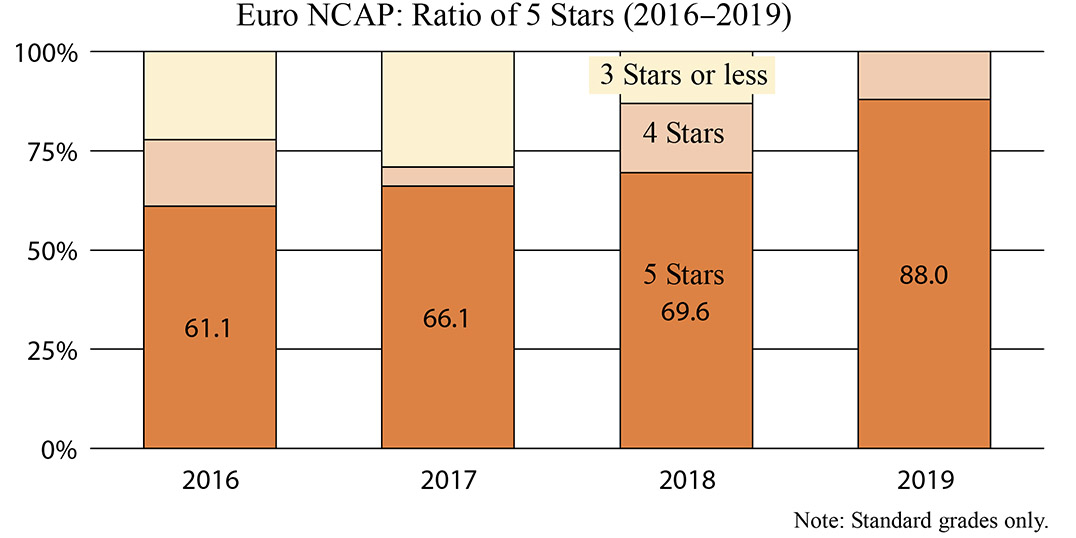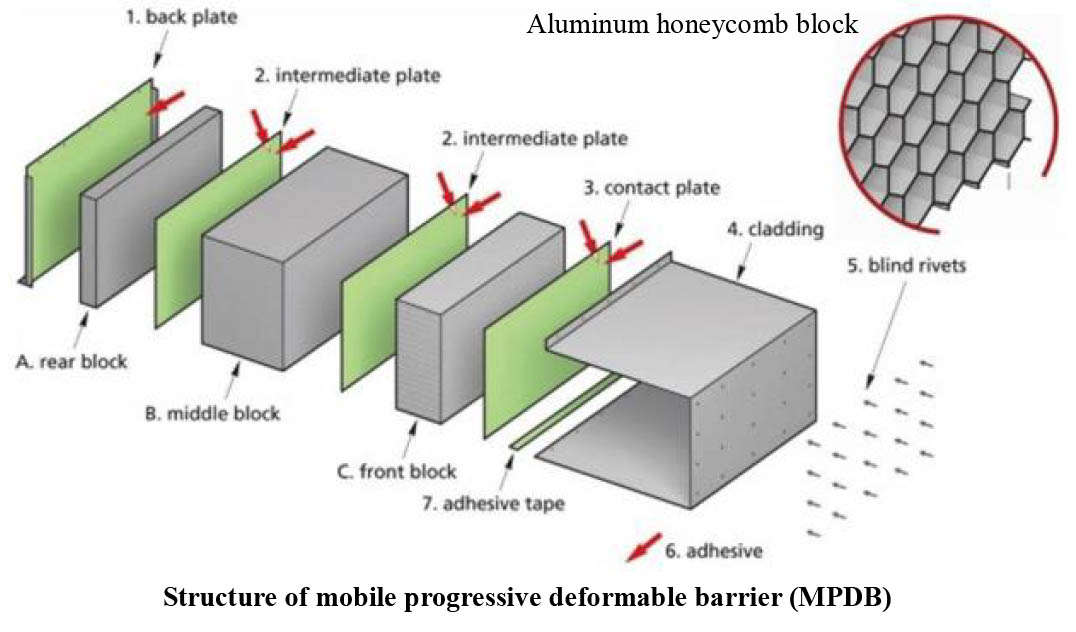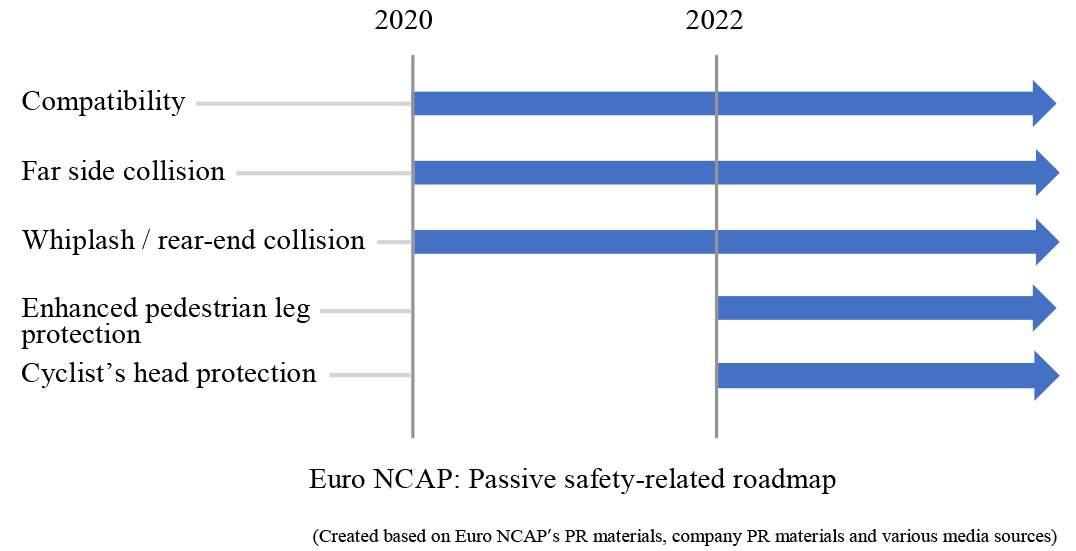AAA weekly
2019-10-21
Copyright FOURIN, Inc. 2025
Center-Side, External Airbags to Be Introduced for Euro NCAP Requirements
Active safety technologies such as Autonomous Emergency Braking (AEB) have been developed to avoid and mitigate damage by predicting collisions in advance. On the other hand, passive safety that suppresses damage after a collision is also advancing.
Euro NCAP, the world leader in safety assessment standards, will add new assessment items related to passive safety in 2020. One of the main features is far-side collision protection. The evaluation is based on the assumption of a collision on the passenger side (far side). Dummies will be added to evaluate the collision between passengers. According to statistics from the European Automobile Manufacturers Association (abbreviated in French as ACEA), the proportion of injuries caused by collisions between passengers or indoor objects and passengers is about 45 percent of the total number of accidents. For this reason, countermeasures are urgently needed.
A center side airbag is a promising technology for far-side collision protection. It is mounted on the side of the seat and is deployed between the driver’s seat and the passenger seat. There are only a few vehicles installed with this technology so far, such as Chevrolet Traverse, but further increase is expected in the future. In September 2019, Hyundai Motor announced that it developed a center-side airbag that is 500g lighter than its predecessor. There is an 80 percent possibility of head-to-head collisions between front seat passengers. Even if no one sits in the passenger seat, a center-side airbag protects the driver in the event of a far-side collision.
Multi-stage (multi-chamber) airbag technology is another trend of airbag development. As an example, Honda has developed a three-chamber front airbag. This airbag consists of three chambers, a center and two sides, which are covered with a mesh-like cover, which looks like a catcher’s mitt. In the event of a collision, the head speed of the front occupants is reduced by 75 percent, lowering neck and brain damage. It was jointly developed with leading airbag manufacturer Autoliv and is scheduled to be installed in the US starting from 2020. Daimler’s safety concept car which was announced in May 2019 is also equipped with a multi-chamber large-capacity airbag.
Euro NCAP Determines the Development Trend of Next-generation Airbag Systems
Euro NCAP and Passive Safety
・Europe’s Euro NCAP and America’s IIHS are the leaders in automobile safety assessment standards around the world. ・The evaluation criteria are reviewed every few years and the number of evaluation items increases. The conditions for obtaining the highest rating of five stars are becoming stricter, but the trend over the past four years shows that the ratio of vehicles that earned five stars has increased. In 2019, 88 percent of all vehicles received five stars and 12 percent earned four stars. There were no models that received three or less stars (as of the end of September 2019). ・Autonomous Emergency Braking (AEB) evaluation was added to Euro NCAP in 2013, indicating the growing importance of active safety.
・However, looking at the scoring standards scheduled for introduction in 2020, there are only 34 active safety-related points out of a total of 157, passive safety still holding the key to high evaluation.
・To increase passive safety, it is necessary to take comprehensive measures by adding airbags to the vehicle’s deformation zones (crashable zones that absorb collision energy) and pretension seatbelts.
– Airbags and seatbelts complement each other. Seatbelts absorb about 70 percent of the collision energy and the rest is mainly absorbed by airbags.
・Autonomous Emergency Braking (AEB) evaluation was added to Euro NCAP in 2013, indicating the growing importance of active safety.
・However, looking at the scoring standards scheduled for introduction in 2020, there are only 34 active safety-related points out of a total of 157, passive safety still holding the key to high evaluation.
・To increase passive safety, it is necessary to take comprehensive measures by adding airbags to the vehicle’s deformation zones (crashable zones that absorb collision energy) and pretension seatbelts.
– Airbags and seatbelts complement each other. Seatbelts absorb about 70 percent of the collision energy and the rest is mainly absorbed by airbags.
Euro NCAP’s upcoming main review items (passive safety-related)
・From 2020, compatibility assessment will be added. – Compatibility evaluation is a performance evaluation, focusing on the damage caused by a vehicle as well as damage incurred by the vehicle. For example, in a frontal collision between a large SUV and a light vehicle, the damage of the light vehicle is generally large. – The Euro NCAP compatibility evaluation considers not only the weight difference but also the shape difference and rigidity difference.

– Instead of the conventional offset deformable barrier (ODB), a mobile progressive deformable barrier (MPDB) is used. MPDB is mainly composed of three aluminum honeycomb blocks, and the degree of damage can be evaluated by the degree of deformation. ・After 2020, far-side collisions will be added to the evaluation items. – It evaluates collisions occurring on the opposite side of the driver’s seat. This is done in two settings: pole side collision and side collision. – A dummies are added to evaluate the collision between passengers. – Adult occupant protection (AOP) will account for four points out of 38 in 2020/2021 and four points out of 40 in 2022/2023. ・From 2020, whiplash and rear end collision protection will be added to the evaluation. ・From 2022, as part of pedestrian protection / vulnerable road users (PP / VRU) leg protection will be strengthened and cyclist’s head protection will be added.


Airbag Use: Current Situation and Future Prospects
Airbag installation situation in 2019
・Looking at the 2019 models that were evaluated by Euro NCAP, the front collision protection front airbag (driver's seat / passenger seat), side impact protection side airbags for head protection (driver's seat / passenger seat / rear) and side impact protection side airbags for chest protection (driver's seat / passenger seat) are 100 percent installed. Installation rate of front collision protection front airbag for knee protection and side collision protection side airbag for pelvis protection is still low (see table below). ・Ten airbags (driver / passenger front and knee, front and rear side, curtain) are standard on models in the upper class of the popular price range (Toyota Camry etc.), near luxury class (Lexus ES etc.) and higher. The number of models is on the rise.Future airbag installation prospects and development trends
 ・Since a far-side collision evaluation will be introduced by Euro NCAP after 2020 and an additional dummy will be added for evaluations, it is expected that more center-side airbags will be installed in the future to prevent head-to-head collision between passengers.
– According to the European Automobile Manufacturers Association (abbreviated in French as ACEA) statistics, the proportion of injuries caused by collision between passengers or indoor objects and passengers is about 45 percent.
–There are still few vehicles with center-side airbags. One of the few examples is GM’s Chevrolet Traverse. The airbag was installed in the 2013 MY for the first time and it is continued to be used ever since.
・In addition, assuming the occupants’ behavior at the time of a collision, a multi-chamber (multi-stage) deployed in a complex manner is planned to be developed.
・A pre-crash system, such as a pretension seatbelt, that predicts a collision in advance and deploys an airbag is also coming soon.
・AD / ADAS will make it possible for passengers to ride more freely. For this reason, a new innovation that controls the deployment of airbags by understanding the seating position and body size of passengers in conjunction with cabin monitoring and seat sensors will be launched.
– For example, ZF acquired 90 percent of the shares of Simi Reality Motion Systems (Germany), which develops occupant behavior recognition software, in May 2019 to create such a mechanism.
・Although external airbags have yet to gain popularity, their use may increase in the future to protect pedestrians and cyclists.
・Since a far-side collision evaluation will be introduced by Euro NCAP after 2020 and an additional dummy will be added for evaluations, it is expected that more center-side airbags will be installed in the future to prevent head-to-head collision between passengers.
– According to the European Automobile Manufacturers Association (abbreviated in French as ACEA) statistics, the proportion of injuries caused by collision between passengers or indoor objects and passengers is about 45 percent.
–There are still few vehicles with center-side airbags. One of the few examples is GM’s Chevrolet Traverse. The airbag was installed in the 2013 MY for the first time and it is continued to be used ever since.
・In addition, assuming the occupants’ behavior at the time of a collision, a multi-chamber (multi-stage) deployed in a complex manner is planned to be developed.
・A pre-crash system, such as a pretension seatbelt, that predicts a collision in advance and deploys an airbag is also coming soon.
・AD / ADAS will make it possible for passengers to ride more freely. For this reason, a new innovation that controls the deployment of airbags by understanding the seating position and body size of passengers in conjunction with cabin monitoring and seat sensors will be launched.
– For example, ZF acquired 90 percent of the shares of Simi Reality Motion Systems (Germany), which develops occupant behavior recognition software, in May 2019 to create such a mechanism.
・Although external airbags have yet to gain popularity, their use may increase in the future to protect pedestrians and cyclists.
Airbags tend to be recalled
・In recent years, recall cases have been particularly noticeable due to defects in airbag control software and inflators. – Looking at data for the first half of 2019, airbags and safety-related equipment account for the majority of recalls in Europe and the United States. – In particular, after the Takata recalls, OEMs have become more sensitive to airbag-related problems and are not hesitant to apply for recall.Major airbag suppliers
 ・In the airbag market, Autoliv (Sweden), Joyson Safety Systems (US) and ZF (Germany) are the top three companies, accounting for 81 percent of global sales (at the end of 2018, based on Autoliv’s data).
– Joyson Safety Systems was formed by the merger of Key Safety Systems and Takata. Takata, once having the second largest share in the global airbag market, applied for the Civil Rehabilitation Act in 2017. In 2018, Chinese-owned Key Safety Systems (KSS) acquired Takata for 1.6 billion USD in a deal under which KSS gets all Takata assets aside from those making replacement air bag inflators. Following the acquisition, KSS changed its name to Joyson Safety Systems.
– ZF’s airbag business is centered on TRW which was acquired by ZF in 2014.
・In the airbag market, Autoliv (Sweden), Joyson Safety Systems (US) and ZF (Germany) are the top three companies, accounting for 81 percent of global sales (at the end of 2018, based on Autoliv’s data).
– Joyson Safety Systems was formed by the merger of Key Safety Systems and Takata. Takata, once having the second largest share in the global airbag market, applied for the Civil Rehabilitation Act in 2017. In 2018, Chinese-owned Key Safety Systems (KSS) acquired Takata for 1.6 billion USD in a deal under which KSS gets all Takata assets aside from those making replacement air bag inflators. Following the acquisition, KSS changed its name to Joyson Safety Systems.
– ZF’s airbag business is centered on TRW which was acquired by ZF in 2014.
 Notes: Covers standard grades only. Calculated giving 1 for standard installation, 0.5 for optional installation and 0 for non-installation. If airbag evaluation could not be carried out (for example, the rear of a two-seater model), the model was excluded. 2019: The BMW Z4 had top installation rate with nine out of 10 evaluation items standardized. Out of the 15 items evaluated, the Mercedes-Benz G-Class received top score for having 11 items standardized and one item optional. 2018: The Lexus ES had top installation rate with 13 out of 13 evaluation items standardized. Out of the 15 items evaluated, the Volvo XC40 received top score for having 10 items standardized.
(Created based on Euro NCAP’s PR materials, IIHS’s PR materials and company PR materials)
Notes: Covers standard grades only. Calculated giving 1 for standard installation, 0.5 for optional installation and 0 for non-installation. If airbag evaluation could not be carried out (for example, the rear of a two-seater model), the model was excluded. 2019: The BMW Z4 had top installation rate with nine out of 10 evaluation items standardized. Out of the 15 items evaluated, the Mercedes-Benz G-Class received top score for having 11 items standardized and one item optional. 2018: The Lexus ES had top installation rate with 13 out of 13 evaluation items standardized. Out of the 15 items evaluated, the Volvo XC40 received top score for having 10 items standardized.
(Created based on Euro NCAP’s PR materials, IIHS’s PR materials and company PR materials)
Interlocking with sensors is an important point in future airbag development. There are two directions. One is to recognize the seating position and body size of the occupant through driver monitoring and cabin monitoring. The other is to operate predictively like a pre-crash seatbelt using cameras for advanced driver assistance systems (ADAS), millimeter wave radar, LiDAR, and other technologies.
In both cases, major airbag suppliers are focusing on development. In May 2019, ZF acquired 90 percent of Germany’s Simi Reality Motion Systems, which develops occupant behavior recognition software, and made it a subsidiary in order to acquire the said software system. As an example of the software, a pre-crash external airbag was announced in June 2019. The airbag attached to the side of the door opens just before the collision.
Research and development accumulated with the aim of autonomous driving and ADAS are also boosting the functionality of airbags.
Automakers / Suppliers: Latest Airbag Systems and Next-generation Concepts
Honda: New front airbag
 ・Honda has developed a new type of front airbag that reduces the speed of the front passenger’s head at the time of collision and reduces neck and brain damage.
– It was jointly developed with Autoliv.
– It will be installed in vehicles in the US from 2020.
・This new airbag has a three-chamber system instead of the conventional single inflation system.
– The three chambers are covered with a mesh-like cover, tailored like a catcher’s mitt.
– It reduces the rotational speed of the head by 75 percent compared to conventional models. Moreover, the occurrence that the head slips on the airbag and slides to the side is also suppressed.
・Honda has developed a new type of front airbag that reduces the speed of the front passenger’s head at the time of collision and reduces neck and brain damage.
– It was jointly developed with Autoliv.
– It will be installed in vehicles in the US from 2020.
・This new airbag has a three-chamber system instead of the conventional single inflation system.
– The three chambers are covered with a mesh-like cover, tailored like a catcher’s mitt.
– It reduces the rotational speed of the head by 75 percent compared to conventional models. Moreover, the occurrence that the head slips on the airbag and slides to the side is also suppressed.

